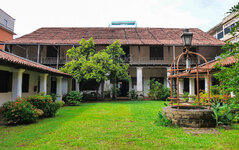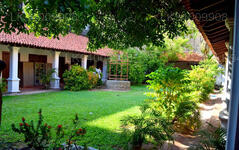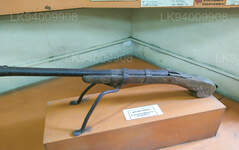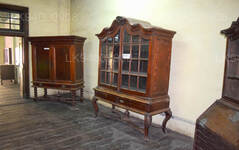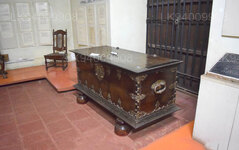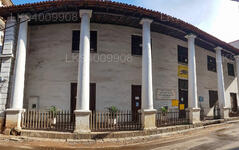
Město Kolombo
Kolombo, hlavní město Srí Lanky, je dynamické město, které mísí tradici s modernou. Představuje koloniální architekturu, živé trhy a klidné buddhistické chrámy. Díky rozmanité kuchyni, rostoucímu panoramatu a krásným plážím je pulzujícím centrem obchodu, kultury a cestovního ruchu a nabízí vstupní bránu k objevování krás Srí Lanky.
Dutch Period Museum
The Construction
In the late 1600s the Dutch era had just started in Sri Lanka. The Dutch were proceeding to destroy all traces of Portuguese occupancy so that their presence would be indelibly established amongst the masses.
They also built many structures to suit their purposes; and Colombo, which had been a port of great importance to the Portuguese, became one of their target locations. The Dutch built hospitals, churches, residences, military barracks, and much more. Amongst these resplendent structures was a colonnaded two-story building, the best of the Dutch architecture from the era.
The building was built in 1692 to be the residence of the Governor of Dutch Ceylon, Thomas van Rhee. Governor van Rhee’s term of office came to an end in 1697, and the structure lost its use as a residence for the Governor. The Dutch had no interest in letting such a big and luxurious (at the time) structure go to seed. They used it for a variety of purposes over the years.
Repurposing
For the next several decades, the 17th century Dutch urban-style residence functioned as a seminary. It became an institution the Dutch used for educating the clergymen who later served in the churches that were being built by them. Towards the latter part of the 18th century, it also served as the residence of Colonel August Carl Frederick Von Ranzow. Afterward, it became an orphanage under the supervision of deacons from the Dutch church and was financed by the Dutch East India Company.
In the late 1700s, the British invaded, and in 1796 the rule of the much-contested island of Sri Lanka was taken over by the British. Another round of building and restructuring followed their arrival, as once again the British tried to erase as many traces of their predecessors, or at least make what was leftover part of their own culture.
The structure of the Dutch Museum, which until then had been an orphanage, got converted into a military hospital to handle the wounded from the battles that the British were waging in the vicinity of Colombo. It served as a hospital for almost half a century, until it became converted into military barracks in the latter half of the 19th century.
At the turn of the century, in the year 1900, the British decided to convert the place into a police training school. It served in such a manner until the year 1932 when the old Dutch building became the Pettah Post Office in the now flourishing city of Colombo.
The Fall of a Monument
Though the building was large and spacious, and quite comfortable for the purpose, it wasn’t to be for long. In 1971, the age-weakened outer walls collapsed during the heavy monsoonal rains of Sri Lanka. The entire structure was deemed dangerous and immediately abandoned.
Restoration and opening of the Museum
With the location being a valuable piece of real estate, as it was right in the middle of the business center of Colombo at the time, the ruined structure was slated for demolition by the government. However, intense protests by the Royal Asiatic Society and the Dutch Burgher Union prevented such plans.
In 1973, a decision was made to restore the building and convert it into a museum for Dutch colonial-era artifacts. As such a committee was established with representatives from the Ceylon Tourist Board, the Department of Archaeology, the Netherlands Alumni Association of Lanka, and the National Archives.
Meetings were held and plans made, In 1977, restoration was started on the old Dutch building with the sponsorship of the Netherlands government. The structure was rebuilt to the exact specifications of the former building and was completed in 1981. It portrayed the unique architectural features of a colonial Dutch townhouse.
The structure opened its doors as a museum to the public in 1982. Over 3000 Dutch era artifacts were stored and displayed there. Amongst the displays were furniture, ceramics, coins, and weaponry that showed off the many facets of contemporary life and culture in the Dutch Colonial Era of Sri Lanka.
In 1999, the value of the Museum as a historical monument was recognized by the Sri Lankan government. On the 18th of June 1999, they formally declared it an archaeologically protected monument of Sri Lanka under Gazette Number 1085.
To this day, the artifacts in the Dutch Museum and the history that pervades its halls make it a huge draw for locals and tourists alike.
O okrese Colombo
Kolombo je největší město a obchodní centrum Srí Lanky. Nachází se na západním pobřeží ostrova a sousedí se Srí Džajavardanepura Kotte, hlavním městem Srí Lanky. Kolombo je rušné a živé město se směsicí moderního života, koloniálních budov a ruin a má 647 100 obyvatel. Metropolitní region Kolombo, vymezený okresy Kolombo, Gampaha a Kalutara, má odhadovanou populaci 5 648 000 a rozkládá se na ploše 3 694,20 km². Kolombo je multietnické a multikulturní město. Je to nejlidnatější město na Srí Lance, v jehož městských hranicích žije 642 163 lidí. Počet obyvatel Kolomba je směsicí mnoha etnických skupin, zejména Sinhálců, Maurů a Tamilů. Ve městě žijí také malé komunity lidí čínského, portugalského, nizozemského, malajského a indického původu, stejně jako četní evropští emigranti. Velká většina srílanských společností má svá ústředí v Kolombu. Mezi průmyslová odvětví patří chemický, textilní, sklářský, cementářský, kožený, nábytkářský a šperkovský průmysl. V centru města se nachází druhá nejvyšší budova v jižní Asii - Světové obchodní centrum.
O Západní provincii
Západní provincie je nejhustěji osídlenou provincií Srí Lanky. Nachází se zde hlavní město zákonodárného sboru Sri Jayawardenepura Kotte a také Colombo, administrativní a obchodní centrum země. Západní provincie se dělí na 3 hlavní okresy s názvem Colombo (642 km²), Gampaha (1 386,6 km²) a Kalutara (1 606 km²). Město je ekonomickým centrem Srí Lanky a sídlí zde všechny hlavní místní i mezinárodní korporace, stejně jako všichni hlavní designoví a maloobchodní prodejci, takže se připravte na nákupní terapii v západní provincii. Západní provincie má nejvyšší populaci ze všech provincií a téměř všechny přední vzdělávací instituce na ostrově se nacházejí v ní. Mezi univerzity v provincii patří Univerzita v Colombu, Univerzita Sri Jayewardenepura, Univerzita v Kelaniya, Otevřená univerzita na Srí Lance, Buddhistická a pálijská univerzita na Srí Lance, Univerzita obrany generála sira Johna Kotelawaly a Univerzita v Moratuwě. Západní provincie má největší počet škol v zemi, včetně národních, provinčních, soukromých a mezinárodních škol.

